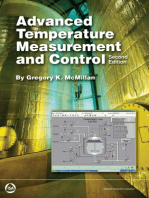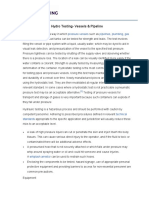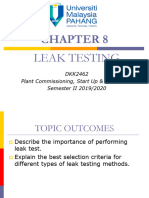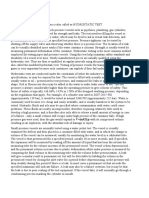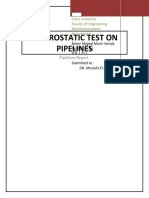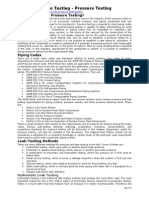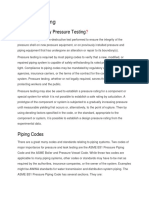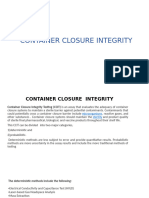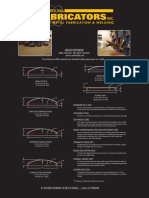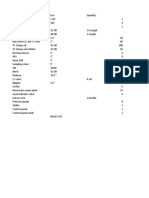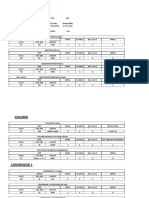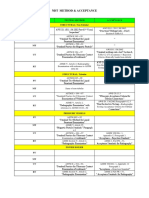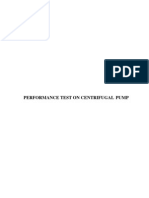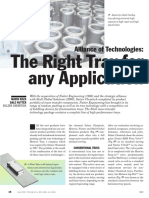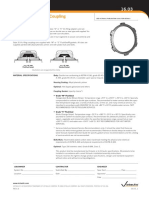Hydrotest Procedure
Hydrotest Procedure
Uploaded by
Varun MalhotraCopyright:
Available Formats
Hydrotest Procedure
Hydrotest Procedure
Uploaded by
Varun MalhotraOriginal Description:
Copyright
Available Formats
Share this document
Did you find this document useful?
Is this content inappropriate?
Copyright:
Available Formats
Hydrotest Procedure
Hydrotest Procedure
Uploaded by
Varun MalhotraCopyright:
Available Formats
Hydrostatic (Hydro) Testing is a process where components such as piping systems, gas
cylinders, boilers, and pressure vessels are tested for strength and leaks. Hydro tests are
often required after shutdowns and repairs in order to validate that equipment will operate
under desired conditions once returned to service.
Furthermore, hydrostatic testing cannot be performed during normal operations and cannot
monitor equipment for leaks after the test has been performed. On-stream equipment
integrity is best managed by an effective fixed equipment mechanical integrity program.
Although hydrostatic testing is considered to be a nondestructive testing method,
equipment can rupture and fail if the inspection exceeds a specified test pressure or if a
small crack propagates rapidly.
How does it work?
Hydrostatic testing is a type of pressure test that works by completely filling the component
with water, removing the air contained within the unit, and pressurizing the system up to 1.5
times the design pressure limit the of the unit. The pressure is then held for a specific
amount of time to visually inspect the system for leaks. Visual inspection can be enhanced
by applying either tracer or fluorescent dyes to the liquid to determine where cracks and
leaks are originating.
Common Methods
There are three common hydrostatic testing techniques that are used to test small pressure
vessels and cylinders: the water jacket method, the direct expansion methodm, and the
proof testing method.
Water Jacket Method
In order to conduct a this method, the the vessel is filled with water and loaded it into a
sealed chamber (called the test jacket) which is also filled with water. The vessel is then
pressurized inside the test jacket for a specified amount of time. This causes the vessel to
expand within the test jacket, which results in water being forced out into a glass tube that
measures the total expansion. Once the total expansion is recorded, the vessel is
depressurized and shrinks to its approximate original size. As the vessel deflates, water
flows back into the test jacket.
Sometimes, the vessel does not return to its original size. This second size value is called
permanent expansion. The difference between the total expansion and permanent
expansion determines whether or not the vessel is fit-for service. Typically the higher the
percent expansion, the more likely the vessel will be decommissioned.
Direct Expansion Method
The direct expansion method involves filling a vessel or cylinder with a specified amount of
water, pressurizing the system, and measuring the amount of water that is expelled once
the pressure is released. The permanent expansion and the total expansion values are
determined by recording the amount of water forced into the vessel, the test pressure, and
amount of water expelled from the vessel.
Proof Pressure Method
The proof pressure test applies an internal pressure and determine if the vessel contains
any leaks or other weakness such as wall thinning that may result in failure. 1 In the United
States, This method is only permitted when the U.S. Code of Federal Regulations does not
require permanent and total expansion values to be recorded.
Alternative Methods
Some equipment may not be designed to handle the loads required for a pressure test. In
these cases, alternative methods such as pneumatic testing should be employed.
Pneumatic testing is another type of pressure test that involves pressurizing the vessel with
a gas such as air or nitrogen instead of water. However, special caution should be used
when performing pneumatic testing as gaseous mediums have the ability to be compressed
and contained in larger amounts compared to hydrostatic testing.
Notes on Hydro Testing
For pipelines, hydro tests are conducted while the pipeline is out of service. All oil and/or
natural gas is typically vented off, and the line is mechanically cleaned prior to testing.
In any case, operators and inspectors should consider the properties of the hydrotest fluid
medium and how the medium may have an effect on the equipment. For example, water is
a good environment for corrosion to take place. Therefore, equipment should be properly
dried and contaminate free before starting operations.
You might also like
- Advanced Temperature Measurement and Control, Second EditionFrom EverandAdvanced Temperature Measurement and Control, Second EditionNo ratings yet
- Hydrotest and Pneumatic Test of Piping Systems-Hydrotest Vs Pneumatic Test With PDFDocument16 pagesHydrotest and Pneumatic Test of Piping Systems-Hydrotest Vs Pneumatic Test With PDFGunawanNo ratings yet
- ASTM D2842 06 Water Absorption Test MethodDocument10 pagesASTM D2842 06 Water Absorption Test MethodAnonymous BXmahb50% (1)
- Measurement and Control Basics, 4th EditionFrom EverandMeasurement and Control Basics, 4th EditionRating: 4 out of 5 stars4/5 (11)
- Mixing Devices Mixers Agitators Etc Supply Verification ITPDocument8 pagesMixing Devices Mixers Agitators Etc Supply Verification ITPVarun Malhotra100% (1)
- Part List HX2T-50NP/D, HX2T - 60NP/DDocument32 pagesPart List HX2T-50NP/D, HX2T - 60NP/Danita shinde100% (3)
- Guideline For The Certification of Wind Turbines Edition 2010 1Document384 pagesGuideline For The Certification of Wind Turbines Edition 2010 1hkowalsk100% (2)
- Excava e PDFDocument22 pagesExcava e PDFFaserphi SacNo ratings yet
- KIT KIT Part # O.E # Items Qty Description: PERKINS 6.354Document1 pageKIT KIT Part # O.E # Items Qty Description: PERKINS 6.354Alexis SanchezNo ratings yet
- Hydro Testing Pressure VesselDocument5 pagesHydro Testing Pressure VesselAkansha Sharma100% (1)
- DKK2462 Chapter 7Document15 pagesDKK2462 Chapter 7rawanisephiaNo ratings yet
- DKK2462 Chapter 8Document14 pagesDKK2462 Chapter 8rawanisephiaNo ratings yet
- Testing Procedures: Water Oil Red Fluorescent DyesDocument2 pagesTesting Procedures: Water Oil Red Fluorescent DyesMayur MandrekarNo ratings yet
- Hydrostatic Test: From Wikipedia, The Free EncyclopediaDocument5 pagesHydrostatic Test: From Wikipedia, The Free EncyclopediaLinlin DuanNo ratings yet
- HAZARDS Pneumatic TestDocument4 pagesHAZARDS Pneumatic TesthazopmanNo ratings yet
- Pressure Testing in Main PipelineDocument7 pagesPressure Testing in Main PipelineChintamani KuralkarNo ratings yet
- Magnetic Particle TestingDocument1 pageMagnetic Particle TestingAdnan AtifNo ratings yet
- Information About Hydrostatic Testing.: Pressure Vessels Pipelines Plumbing Gas Cylinders BoilersDocument1 pageInformation About Hydrostatic Testing.: Pressure Vessels Pipelines Plumbing Gas Cylinders BoilersAdnan AtifNo ratings yet
- Hydrotest Vs Pneumatic TestDocument5 pagesHydrotest Vs Pneumatic TestMidhun K Chandrabose100% (1)
- Pressure Testing Piping SystemsDocument3 pagesPressure Testing Piping SystemsWeny Astuti100% (2)
- Testing Procedures: Pressure Test Which Is Also Called The Modified Hydrostatic Test. Hydrostatic Testing Is Also A WayDocument5 pagesTesting Procedures: Pressure Test Which Is Also Called The Modified Hydrostatic Test. Hydrostatic Testing Is Also A Wayvaresh111No ratings yet
- Pressure TestingDocument14 pagesPressure TestingWeld Bro Sandeep100% (2)
- Leak Test PDFDocument48 pagesLeak Test PDFdaniel oliveira100% (1)
- Hydrostatic Test - Wikipedia, The Free EncyclopediaDocument4 pagesHydrostatic Test - Wikipedia, The Free Encyclopediaramthecharm_46098467No ratings yet
- Hydrostatic Pressure Testing On Operating PipelinesDocument2 pagesHydrostatic Pressure Testing On Operating PipelinesAndres Fitria FarrelNo ratings yet
- Hydro Vs PneumaticDocument4 pagesHydro Vs PneumaticAnonymous rYZyQQot55No ratings yet
- Pressure Test System To Demonstrate Integrity: by Anil Kumar SaxenaDocument47 pagesPressure Test System To Demonstrate Integrity: by Anil Kumar SaxenaThe Engineers EDGE, Coimbatore100% (3)
- Fsa PSJ 701 06 PDFDocument9 pagesFsa PSJ 701 06 PDFAshitava Sen100% (1)
- Hydrotest Procedure C 6 23Document19 pagesHydrotest Procedure C 6 23savanth jayaramNo ratings yet
- Test Pressure: Pressure Vessels Pipelines Plumbing Gas Cylinders BoilersDocument1 pageTest Pressure: Pressure Vessels Pipelines Plumbing Gas Cylinders BoilersNaveed AslamNo ratings yet
- Baher M. EL-Gendy Section (2) B.N.Document7 pagesBaher M. EL-Gendy Section (2) B.N.Baher M. El-GendyNo ratings yet
- NDT Pressure TestingDocument23 pagesNDT Pressure TestingRamu Nallathambi100% (2)
- HDPE Testing ProcedureDocument4 pagesHDPE Testing ProcedureaneezmhdNo ratings yet
- Pressure Tests of Piping Systems-Hydrotest Vs Pneumatic TestDocument4 pagesPressure Tests of Piping Systems-Hydrotest Vs Pneumatic TestRakesh RanjanNo ratings yet
- Leak Detection Methods: A Comparative Study of Technologies and Techniques Short VersionDocument24 pagesLeak Detection Methods: A Comparative Study of Technologies and Techniques Short VersionHappy202183% (6)
- Pressure & Leak TestingDocument18 pagesPressure & Leak TestingBilly Kurniawan100% (1)
- The Primary Purpose of A PST or Production TestDocument8 pagesThe Primary Purpose of A PST or Production TestGisela Hernandez GuevaraNo ratings yet
- Hydrostatic Test and Pneumatic Test of Piping Systems-Hydrotest Vs Pneumatic Test With PDFDocument15 pagesHydrostatic Test and Pneumatic Test of Piping Systems-Hydrotest Vs Pneumatic Test With PDFYudha Andrie Sasi ZenNo ratings yet
- Step Changing in Well Test OperationDocument10 pagesStep Changing in Well Test OperationAnugrah FadhlanNo ratings yet
- Pressure Tests of Piping SystemsDocument14 pagesPressure Tests of Piping SystemsharishcsharmaNo ratings yet
- Leak TestDocument11 pagesLeak Testamr.alrawafNo ratings yet
- Wireline Formation TesterDocument35 pagesWireline Formation TesterRasheed100% (1)
- Hydro Static Universal Field Test ProcedureDocument16 pagesHydro Static Universal Field Test ProcedureHarvey Svetlik100% (1)
- Production Logging For Reservoir TestingDocument5 pagesProduction Logging For Reservoir Testingmahimoh18No ratings yet
- Leak TestingDocument27 pagesLeak TestingNurulAtirahNoroziNo ratings yet
- Chapter 3 - Groundwater Flow To WellsDocument92 pagesChapter 3 - Groundwater Flow To WellsCarlos Chévez100% (1)
- Introduction To Well TestingDocument39 pagesIntroduction To Well TestingzazoNo ratings yet
- Introduction To Well TestingDocument38 pagesIntroduction To Well TestingKhalil Hdedeh100% (1)
- Midterm - Unit OpsDocument19 pagesMidterm - Unit OpsKrizzia Anne ShengNo ratings yet
- Pozo SikuDocument2 pagesPozo SikuDjoko WidodoNo ratings yet
- Well Testing ProjectDocument24 pagesWell Testing ProjectLuis Abdul-MelendezNo ratings yet
- Hydrostatic Pressure Test of Drinking Water PipesDocument6 pagesHydrostatic Pressure Test of Drinking Water PipesScribdTranslationsNo ratings yet
- Liquid Permeability Measurement ExperimentDocument14 pagesLiquid Permeability Measurement ExperimentMohamed Moder100% (1)
- Container Closure Integrity TestingDocument14 pagesContainer Closure Integrity Testingbasu68No ratings yet
- Hydrotesting of ShellDocument4 pagesHydrotesting of Shellmsaqibraza93No ratings yet
- Hydro Testing Handbook: Principles, Practices, Applications, Formulas, and Common Q&AFrom EverandHydro Testing Handbook: Principles, Practices, Applications, Formulas, and Common Q&ANo ratings yet
- Standard methods for the examination of water and sewageFrom EverandStandard methods for the examination of water and sewageNo ratings yet
- Systematic Methods of Water Quality Parameters Analysis: Analytical MethodsFrom EverandSystematic Methods of Water Quality Parameters Analysis: Analytical MethodsRating: 1 out of 5 stars1/5 (1)
- Diagnosis and Robust Control of Complex Building Central Chilling Systems for Enhanced Energy PerformanceFrom EverandDiagnosis and Robust Control of Complex Building Central Chilling Systems for Enhanced Energy PerformanceNo ratings yet
- Types of Valves in Piping: Types of Valves - Tables to estimate man hours of assemblyFrom EverandTypes of Valves in Piping: Types of Valves - Tables to estimate man hours of assemblyNo ratings yet
- Check Weigher: Revolutionizing Quality Control with Computer VisionFrom EverandCheck Weigher: Revolutionizing Quality Control with Computer VisionNo ratings yet
- Optimising Car Performance Modifications: - Simple methods for measuring engine, suspension, brakes and aerodynamic performance gainsFrom EverandOptimising Car Performance Modifications: - Simple methods for measuring engine, suspension, brakes and aerodynamic performance gainsNo ratings yet
- Ultrasound Analysis for Condition Monitoring: Applications of Ultrasound Detection for Various Industrial EquipmentFrom EverandUltrasound Analysis for Condition Monitoring: Applications of Ultrasound Detection for Various Industrial EquipmentRating: 4.5 out of 5 stars4.5/5 (3)
- Flow charts of pharmaceutical quality control tests for different dosage formsFrom EverandFlow charts of pharmaceutical quality control tests for different dosage formsNo ratings yet
- Curriculum Vitae: Company ProfileDocument2 pagesCurriculum Vitae: Company ProfileVarun MalhotraNo ratings yet
- Cash MemoDocument1 pageCash MemoVarun MalhotraNo ratings yet
- Product CatalogueDocument2 pagesProduct CatalogueVarun MalhotraNo ratings yet
- Haryana Suggestive Pay PacksDocument10 pagesHaryana Suggestive Pay PacksVarun MalhotraNo ratings yet
- Product CatalogueDocument2 pagesProduct CatalogueVarun MalhotraNo ratings yet
- Head Division: If You'Re Looking To Get A Head........ Call Us Today!!Document1 pageHead Division: If You'Re Looking To Get A Head........ Call Us Today!!Varun MalhotraNo ratings yet
- Nasik SiteDocument1 pageNasik SiteVarun MalhotraNo ratings yet
- Third Party Procedure For Heat Exchanger TestingDocument10 pagesThird Party Procedure For Heat Exchanger TestingVarun MalhotraNo ratings yet
- Malik: Polychem LTDDocument2 pagesMalik: Polychem LTDVarun MalhotraNo ratings yet
- Malik: Polychem LTDDocument2 pagesMalik: Polychem LTDVarun MalhotraNo ratings yet
- Advance Salary JuneDocument1 pageAdvance Salary JuneVarun MalhotraNo ratings yet
- Organizational ChartDocument3 pagesOrganizational ChartVarun MalhotraNo ratings yet
- Chemical Composition of ASTM ASME SA516 Grade 60 70 Steel PlateDocument2 pagesChemical Composition of ASTM ASME SA516 Grade 60 70 Steel PlateVarun Malhotra100% (1)
- REACTOR (101) : Reactor Dish To Open PipeDocument6 pagesREACTOR (101) : Reactor Dish To Open PipeVarun MalhotraNo ratings yet
- Tilak Singh: Employee Work Activity SL No Name DimensionDocument4 pagesTilak Singh: Employee Work Activity SL No Name DimensionVarun MalhotraNo ratings yet
- SL - No Types SCH NB Inches Thick in Stock Used Pipe Pipes RecordDocument6 pagesSL - No Types SCH NB Inches Thick in Stock Used Pipe Pipes RecordVarun MalhotraNo ratings yet
- Malik Polychem Unit - 1: DateDocument2 pagesMalik Polychem Unit - 1: DateVarun MalhotraNo ratings yet
- Malik Polychem: S.No. ResponsblitiesDocument2 pagesMalik Polychem: S.No. ResponsblitiesVarun MalhotraNo ratings yet
- Expense Reimbursement: Itemized ExpensesDocument3 pagesExpense Reimbursement: Itemized ExpensesVarun MalhotraNo ratings yet
- Wps PQR FormatDocument1 pageWps PQR FormatVarun MalhotraNo ratings yet
- Howrocksbehaveunderdifferenttypesofstress ESDocument76 pagesHowrocksbehaveunderdifferenttypesofstress ESepraimmcporNo ratings yet
- GTL Controller setting-TL182-021-00Document20 pagesGTL Controller setting-TL182-021-00uploader1514No ratings yet
- Mohr Circle State Of-StressDocument30 pagesMohr Circle State Of-StressdocsdownforfreeNo ratings yet
- Design Guide 7 - Pinned Based Plate Connections - Design Guide 7 - Pinned Base Plate Connections For Columns 45Document2 pagesDesign Guide 7 - Pinned Based Plate Connections - Design Guide 7 - Pinned Base Plate Connections For Columns 45Neil WayneNo ratings yet
- Centrifugal Pump Test Rig FinalDocument7 pagesCentrifugal Pump Test Rig FinalanimeshkumarvermaNo ratings yet
- Pumps Technical Data SheetsDocument14 pagesPumps Technical Data SheetsJahubar SadiqueNo ratings yet
- Excel Piglet ManualDocument25 pagesExcel Piglet ManualChristo DunstonNo ratings yet
- Bolted Field Splices For Steel Bridge Flexural Members May2017Document62 pagesBolted Field Splices For Steel Bridge Flexural Members May2017clam2014100% (3)
- Gulf Gear EP: Heavy Duty Automotive Gearbox OilDocument1 pageGulf Gear EP: Heavy Duty Automotive Gearbox Oilatripathi2009No ratings yet
- Ajustar El Temps D'injeccióDocument5 pagesAjustar El Temps D'injeccióGuillem Sabate GoulaNo ratings yet
- Total Product CatalogueDocument37 pagesTotal Product CatalogueFARIDNo ratings yet
- CIVIL BREADTH and STRUCTURAL DEPTH Exam Specifications: Principles and Practice of EngineeringDocument6 pagesCIVIL BREADTH and STRUCTURAL DEPTH Exam Specifications: Principles and Practice of Engineeringanandakoe0% (1)
- Gpd150-A N-Max Abs Crankcase Cover 1Document1 pageGpd150-A N-Max Abs Crankcase Cover 1apingNo ratings yet
- Multivariable Control-Oriented Modeling of A DirectDocument9 pagesMultivariable Control-Oriented Modeling of A DirectEva ViskadourakiNo ratings yet
- Option - RelativityDocument54 pagesOption - Relativitymardel11No ratings yet
- CE 3100 Structural Engineering Lab: DR A Meher Prasad DR P S Lakshmi Priya DR Arun MenonDocument36 pagesCE 3100 Structural Engineering Lab: DR A Meher Prasad DR P S Lakshmi Priya DR Arun MenoncbdfgfgfNo ratings yet
- Distillation Tray SelectionDocument4 pagesDistillation Tray Selectionchemsac2No ratings yet
- Style 31 Vic-Ring CouplingDocument2 pagesStyle 31 Vic-Ring CouplingJohan Vilchez EsquivelNo ratings yet
- D3E8001E712-Engine Mechanical Fuel Injection and IgnitionDocument194 pagesD3E8001E712-Engine Mechanical Fuel Injection and IgnitionDaniel SerbanNo ratings yet
- Mini-Plus R410-ADocument96 pagesMini-Plus R410-Amrashid286No ratings yet
- R + X X - R R + 2xDocument7 pagesR + X X - R R + 2xSuDheer KumarNo ratings yet
- AL4 Automatic TransmissionDocument59 pagesAL4 Automatic TransmissionValdir Gomiero100% (1)
- Despiece y Numero de Parte MCH-2, MCH-3, MCH-4Document4 pagesDespiece y Numero de Parte MCH-2, MCH-3, MCH-4jordan navarroNo ratings yet
- Engineering Fit and TolerancesDocument5 pagesEngineering Fit and TolerancesRam TejaNo ratings yet
- EZRail Installation InstructionsDocument8 pagesEZRail Installation InstructionsmarkelovfyodorNo ratings yet
- Clutch Cable Adjustment OneDocument19 pagesClutch Cable Adjustment OneEduardo Yagüe GomezNo ratings yet

